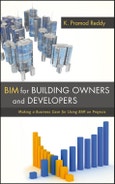HOW to USE BIM to DEVELOP STRATEGIES, EXPEDITE PROJECTS, IMPROVE OUTCOMES, and SAVE MONEY
BIM is far more than an "upgrade" to the latest CAD software. It is a process improvement tool that leverages data to analyze and predict outcomes throughout the different phases of the building life cycle. The time for a building owner to get involved with the BIM process is not at the end of the building project but from the very beginning. BIM for Building Owners and Developers is the only guide that will help you, the owner and client, use BIM to increase transparency and create a more integrated design and construction process, which will result in better quality buildings at lower cost and in a shorter time frame. It will also help you understand what BIM can do for you and what you can expect in terms of process and commitments. You′ll discover how BIM can help improve your strategic planning, maximize ROI, support the decision–making processes, and fine–tune GAP analysis.
In addition, BIM for Building Owners and Developers can help you:
- Understand, manage, and take advantage of the BIM paradigm shift
- Assemble a building as it would be constructed on site to help eliminate many inefficiencies of the construction process
- Achieve a high level of coordination through better integration of information and process optimization
- Reduce the overall cost of a project by identifying problems while they still can be corrected inexpensively
BIM for Building Owners and Developers helps make every project easier, faster, and more profitable.
Table of Contents
Preface ixAcknowledgments x
Chapter 1 Introduction to Building Information Modeling 1
The History of BIM 3
Future Trends 6
Facility Management Systems 10
Building Owner Objectives 17
User Experience 20
Communication 23
Procurement 24
Design Guidelines 26
Construction Process and Costs 28
Sustainability 31
Preventive Maintenance 35
Chapter Summary Key Points 37
Chapter 2 BIM with a Purpose 41
Architect′s BIM 43
Contractor′s BIM 48
Building Product Manufacturer′s BIM 50
Owner′s BIM 65
Data Standards 75
The Owner′s BIM Requirements Document 79
Chapter Summary Key Points 114
Chapter 3 BIM The Paradigm Shift 117
Historical Paradigm Shifts 124
Responding to a Paradigm Shift 126
Organizational Impact of a Paradigm Shift 130
Cultural Assessment 131
The Velocity of Technology Adoption 133
Chapter 4 Strategic Planning 139
Development of a SWOT Analysis for an Owner 140
The Three Ps 147
Plan of Action 151
Chapter Summary Key Points 151
Chapter 5 Tactics 153
Gap Analysis 153
The Playbook 159
Educational Leadership 170
BIM Content and Specifi cation Library 173
Chapter Summary Key Points 176
Chapter 6 Execution 177
"Boiling the Ocean" Approach 178
Enterprise Approach 179
Point Solution Approach 179
Compliance Approach 180
Chapter Summary Key Points 182
Chapter 7 BIM Analytics for the Enterprise 183
Measurement: The Return–on–Investment Model 189
Establishing Key Performance Indicators 193
BIM Owner Research 196
The BIM Champion 201
Research Methods 202
Summary of Information 207
Findings and Conclusions 213
Chapter Summary Key Points 214
Chapter 8 Summary 217
Notes 221
Biographies 223
Index 227








